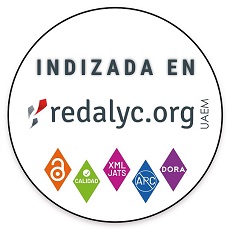Publicado
SOBRE UNA PRUEBA DE LINEALIDAD EN PRESENCIA DE DATOS FALTANTES CONTRA LA ALTERNATIVA DE NO LINEALIDAD ESPECIFICADA POR UN MODELO TAR
TESTING LINEARITY AGAINST A UNIVARIATE TAR SPECIFICATION IN TIME SERIES WITH MISSING DATA
Palabras clave:
datos faltantes, modelos autoregresivos de umbrales, prueba de linealidad, series de tiempo no linales (es)Linearity test, Missing data, Nonlinear time series, Threshold autoregressive model (en)
1Universidad Nacional de Colombia, Facultad de Ciencias, Departamento de Estadística, Bogotá, Colombia. Profesor titular. Email: fhnietos@unal.edu.co
2Universidad Nacional de Colombia, Facultad de Economía, Bogotá, Colombia. Profesora auxiliar. Email: nmhoyosg@unal.edu.co
Nowadays, procedures for testing the null hypothesis of linearity of a (univariate or multivariate) stochastic process are well known, almost all of them based on the assumption that their paths (i.e. observed time series) are complete. This paper describes an approach for testing this null hypothesis in the presence of missing data, using an extension of one of the test statistics used in the literature. The alternative hypothesis is that the univariate stochastic process of interest follows a threshold autoregressive (TAR) model. It is found that if the missing-data percentage is low, the null distribution of the proposed test statistic is maintained; while if it is high, it is not. A threshold value for the missing-data percentage is detected, which can be utilized in practice.
Key words: Linearity test, Missing data, Nonlinear time series, Threshold autoregressive model.
Las pruebas estadísticas que se conocen actualmente para examinar la hipótesis nula de linealidad de un proceso estocástico (univariado o multivariado) están basadas, casi todas, en el supuesto de que las series temporales observadas son completas. En este trabajo, se presenta un nuevo procedimiento para examinar esta hipótesis nula, en presencia de datos faltantes, el cual es una extensión de un método muy citado en la literatura. La hipótesis alternativa especifica que el proceso estocástico de interés obedece a un modelo autoregresivo de umbrales (TAR). Se encuentra que si el porcentaje de observaciones faltantes es bajo, la distribución nula de la estadística de prueba se mantiene; en otro caso no. El estudio arroja un valor umbral para este porcentaje, el cual puede ser usado en la práctica.
Palabras clave: datos faltantes, modelos autoregresivos de umbrales, prueba de linealidad, series de tiempo no linales.
Texto completo disponible en PDF
References
1. Brockwell, P. J. (1994), `On continuous-time threshold ARMA processes´, Journal of Statistical Planning and Inference 39, 291-303.
2. Brockwell, P. J. & Davis, R. A. (1991), Time Series: Theory and Methods, Springer-Verlag, New York.
3. Caporello, G. & Maravall, A. (2003), Software TSW, Banco de Espa\~na, Madrid.
4. Carter, C. K. & Kohn, R. (1994), `On Gibbs sampling for state space models´, Biometrika 81, 541-553.
5. Carter, C. K. & Kohn, R. (1996), `Markov chain Monte Carlo in conditionally gaussian state space models´,Biometrika 83, 589-601.
6. Catlin, D. (1989), Estimation, Control, and the Discrete Kalman Filter, Springer-Verlag, New York.
7. G\'omez, V. & Maravall, A. (1994), `Estimation, prediction, and interpolation for nonstationary series with the Kalman filter´, Journal of the American Statistical Association 89, 611-624.
8. Hansen, B. E. (1996), `Inference when a nuisance parameter is not identified under the null hypothesis´,Econometrica 64, 413-460.
9. Harvey, A. C. (1989), Forecasting, Structural Time Series, and the Kalman filter, Cambridge University Press, Cambridge.
10. Kim, C. & Nelson, C. R. (1999), State Space Models with Regime Switching, The MIT Press, Cambridge.
11. Nieto, F. H. (2005), `Modeling bivariate threshold autoregressive processes in the presence of missing data´,Communications in Statistics - Theory and Methods 34(4), 905-930.
12. Shumway, R. H. & Stoffer, D. S. (1991), `Dynamic linear models with switching´, Journal of the American Statistical Association 86, 411-430.
13. Tong, H. (1978), On a threshold model in pattern recognition and signal processing, `Pattern recognition and signal processing´, Sijhoff & Noordhoff, Amsterdam.
14. Tong, H. & Lim, K. S. (1980), `Threshold autoregression, limit cycles, and cyclical data´, Journal of the Royal Statistical Society, Series B 42, 245-292.
15. Tong, H. & Yeung, I. (1991a), `On tests for self-exciting threshold autoregressive non-linearity in partially observed time series´, Applied Statistics 40, 43-62.
16. Tong, H. & Yeung, I. (1991b), `Threshold autoregressive modeling in continuous time´, Statistica Sinica 1, 411-430.
17. Tsai, H. & Chan, K. S. (2000), `Testing for nonlinearity with partially observed time series´, Biometrika 87, 805-821.
18. Tsay, R. S. (1998), `Testing and modeling multivariate threshold models´, Journal of the American Statistical Association 93, 1188-1202.
Este artículo se puede citar en LaTeX utilizando la siguiente referencia bibliográfica de BibTeX:
@ARTICLE{RCEv34n1a04,AUTHOR = {Nieto, Fabio H. and Hoyos, Milena},
TITLE = {{Testing Linearity against a Univariate TAR Specification in Time Series with Missing Data}},
JOURNAL = {Revista Colombiana de Estadística},
YEAR = {2011},
volume = {34},
number = {1},
pages = {73-94}
}
Cómo citar
APA
ACM
ACS
ABNT
Chicago
Harvard
IEEE
MLA
Turabian
Vancouver
Descargar cita
Visitas a la página del resumen del artículo
Descargas
Licencia
Derechos de autor 2011 Revista Colombiana de Estadística

Esta obra está bajo una licencia internacional Creative Commons Atribución 4.0.
- Los autores/as conservarán sus derechos de autor y garantizarán a la revista el derecho de primera publicación de su obra, el cuál estará simultáneamente sujeto a la Licencia de reconocimiento de Creative Commons (CC Atribución 4.0) que permite a terceros compartir la obra siempre que se indique su autor y su primera publicación esta revista.
- Los autores/as podrán adoptar otros acuerdos de licencia no exclusiva de distribución de la versión de la obra publicada (p. ej.: depositarla en un archivo telemático institucional o publicarla en un volumen monográfico) siempre que se indique la publicación inicial en esta revista.
- Se permite y recomienda a los autores/as difundir su obra a través de Internet (p. ej.: en archivos telemáticos institucionales o en su página web) antes y durante el proceso de envío, lo cual puede producir intercambios interesantes y aumentar las citas de la obra publicada. (Véase El efecto del acceso abierto).
















